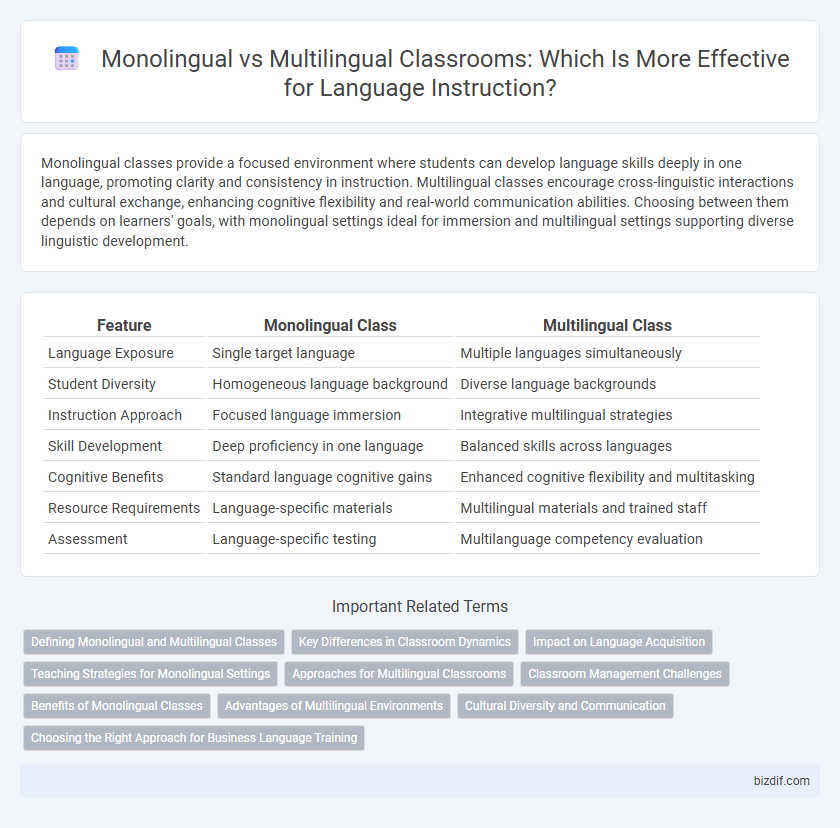Monolingual classes provide a focused environment where students can develop language skills deeply in one language, promoting clarity and consistency in instruction. Multilingual classes encourage cross-linguistic interactions and cultural exchange, enhancing cognitive flexibility and real-world communication abilities. Choosing between them depends on learners' goals, with monolingual settings ideal for immersion and multilingual settings supporting diverse linguistic development.
Table of Comparison
| Feature | Monolingual Class | Multilingual Class |
|---|---|---|
| Language Exposure | Single target language | Multiple languages simultaneously |
| Student Diversity | Homogeneous language background | Diverse language backgrounds |
| Instruction Approach | Focused language immersion | Integrative multilingual strategies |
| Skill Development | Deep proficiency in one language | Balanced skills across languages |
| Cognitive Benefits | Standard language cognitive gains | Enhanced cognitive flexibility and multitasking |
| Resource Requirements | Language-specific materials | Multilingual materials and trained staff |
| Assessment | Language-specific testing | Multilanguage competency evaluation |
Defining Monolingual and Multilingual Classes
Monolingual classes consist of students who share the same native language, enabling instruction to be tailored specifically to their linguistic and cultural background, which enhances comprehension and engagement. Multilingual classes bring together learners with diverse linguistic backgrounds, requiring educators to adopt inclusive teaching strategies that address varying language proficiencies and promote cross-linguistic skills. Understanding these definitions helps educators design effective curricula that meet the specific needs of homogeneous or heterogeneous language groups.
Key Differences in Classroom Dynamics
Monolingual classes often feature uniform language proficiency, which simplifies instruction and enables targeted vocabulary development tailored to a single linguistic group. Multilingual classes present diverse language backgrounds, requiring differentiated teaching strategies and promoting intercultural communication skills among students. Classroom dynamics differ as monolingual settings emphasize depth within one language, while multilingual environments foster language negotiation and code-switching practices.
Impact on Language Acquisition
Monolingual classes provide a focused environment where students can deeply immerse in a single language, often leading to stronger foundational skills and faster initial acquisition. Multilingual classes promote cognitive flexibility and cross-linguistic transfer, enhancing overall linguistic competence but may slow acquisition speed due to divided language exposure. Research shows that the impact on language acquisition depends on factors like instructional quality, learner motivation, and the specific goals of language proficiency.
Teaching Strategies for Monolingual Settings
Teaching strategies for monolingual classrooms emphasize immersive language exposure through targeted vocabulary drills, contextualized grammar exercises, and interactive speaking activities that reinforce the single language environment. Educators often utilize scaffolding techniques, visual aids, and repetitive practice tailored to the native language proficiency level to build fluency and comprehension. Structured lesson plans prioritize consistency and clarity, minimizing code-switching to maintain focus on language acquisition within the monolingual context.
Approaches for Multilingual Classrooms
Effective approaches for multilingual classrooms emphasize differentiated instruction tailored to diverse linguistic backgrounds, integrating both students' native languages and the target language to build comprehension and engagement. Strategies include collaborative learning, culturally responsive teaching, and the use of visual aids that support language acquisition across proficiency levels. Scaffolded instruction and language-rich environments foster inclusivity and maximize academic outcomes for all learners.
Classroom Management Challenges
Monolingual classes present streamlined classroom management with uniform language use, reducing misunderstandings and facilitating consistent communication. In contrast, multilingual classes introduce challenges such as language barriers that can hinder student engagement and require differentiated instructional strategies. Teachers must balance diverse linguistic needs while maintaining discipline and fostering an inclusive learning environment.
Benefits of Monolingual Classes
Monolingual classes enhance language acquisition by providing a fully immersive environment where students interact exclusively in the target language, improving fluency and comprehension. These classes minimize confusion and cognitive overload often caused by code-switching found in multilingual settings. Focused instruction tailored to one language also supports consistent practice and faster mastery of vocabulary and grammatical structures.
Advantages of Multilingual Environments
Multilingual classrooms enhance cognitive flexibility by exposing students to diverse languages, which strengthens problem-solving and critical thinking skills. These environments foster cultural awareness and empathy, promoting inclusive communication and global citizenship. Research shows that students in multilingual settings often achieve higher academic performance and improved language proficiency compared to monolingual classes.
Cultural Diversity and Communication
Monolingual classes often provide focused language instruction but may lack exposure to diverse cultural perspectives, limiting students' communicative competence in global contexts. Multilingual classes enhance cultural diversity by incorporating multiple languages, fostering cross-cultural communication skills and empathy among students. Exposure to varied linguistic backgrounds in multilingual settings promotes adaptability and broadens students' understanding of different cultural nuances essential for effective communication.
Choosing the Right Approach for Business Language Training
Businesses must evaluate employee language proficiency and target markets when choosing between monolingual or multilingual classes for language training. Monolingual classes offer focused, in-depth learning of a single language, ideal for specialized skill development. Multilingual classes provide cost-effective solutions by addressing diverse language needs simultaneously, enhancing cross-cultural communication in global teams.
Monolingual Class vs Multilingual Class Infographic

 bizdif.com
bizdif.com